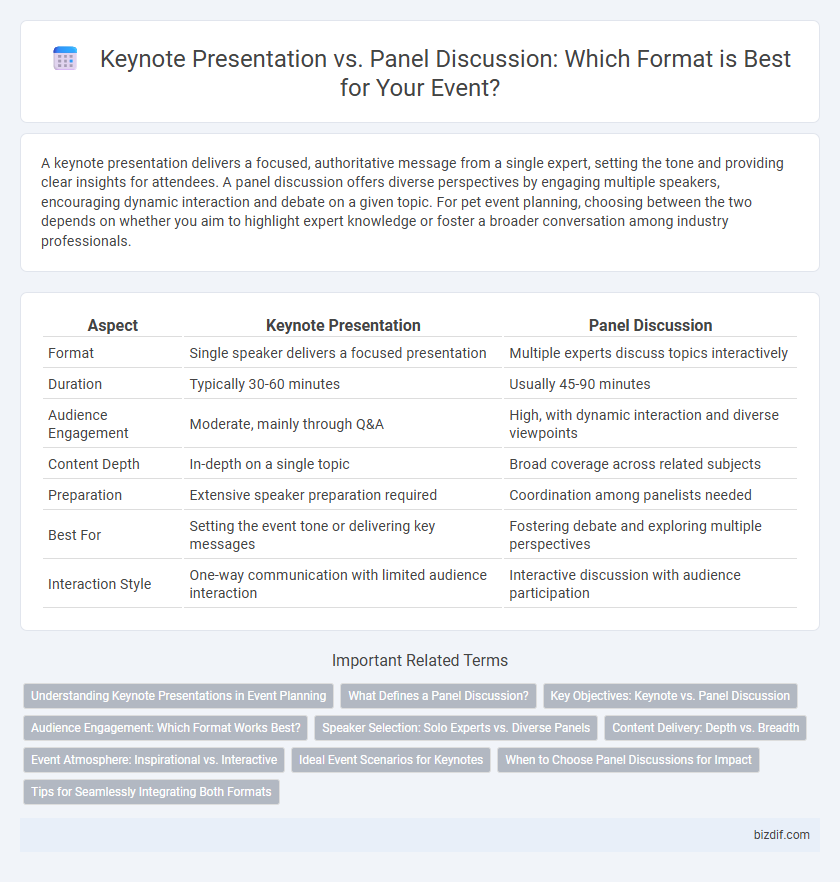A keynote presentation delivers a focused, authoritative message from a single expert, setting the tone and providing clear insights for attendees. A panel discussion offers diverse perspectives by engaging multiple speakers, encouraging dynamic interaction and debate on a given topic. For pet event planning, choosing between the two depends on whether you aim to highlight expert knowledge or foster a broader conversation among industry professionals.
Table of Comparison
| Aspect | Keynote Presentation | Panel Discussion |
|---|---|---|
| Format | Single speaker delivers a focused presentation | Multiple experts discuss topics interactively |
| Duration | Typically 30-60 minutes | Usually 45-90 minutes |
| Audience Engagement | Moderate, mainly through Q&A | High, with dynamic interaction and diverse viewpoints |
| Content Depth | In-depth on a single topic | Broad coverage across related subjects |
| Preparation | Extensive speaker preparation required | Coordination among panelists needed |
| Best For | Setting the event tone or delivering key messages | Fostering debate and exploring multiple perspectives |
| Interaction Style | One-way communication with limited audience interaction | Interactive discussion with audience participation |
Understanding Keynote Presentations in Event Planning
Keynote presentations in event planning serve as the focal point, delivering a compelling message to set the tone and establish the event's theme. These presentations typically feature a single expert speaker who captivates the audience with in-depth insights and motivational content. Unlike panel discussions, keynotes provide a structured narrative designed to inspire and inform, making them essential for driving engagement and coherence throughout the event.
What Defines a Panel Discussion?
A panel discussion features multiple experts sharing diverse perspectives on a specific topic, encouraging dynamic interaction and audience engagement. Unlike a keynote presentation delivered by a single speaker, a panel fosters dialogue, debate, and real-time exchange of ideas among panelists. Effective panel discussions enhance event value by providing varied insights and promoting critical thinking among attendees.
Key Objectives: Keynote vs. Panel Discussion
Keynote presentations deliver a focused, authoritative message from a single expert, aiming to inspire and inform the audience with clear, impactful insights. Panel discussions foster diverse perspectives through interactive dialogue among multiple experts, encouraging audience engagement and deeper exploration of complex topics. Choosing between formats depends on whether the primary objective is to convey a unified vision or to facilitate dynamic, multifaceted conversations.
Audience Engagement: Which Format Works Best?
Keynote presentations captivate audiences through focused storytelling and expert insights, creating a clear, memorable message that resonates deeply. Panel discussions stimulate dynamic interaction and diverse perspectives, encouraging audience participation and real-time engagement. Selecting the optimal format depends on event goals, desired audience involvement, and the complexity of the topic to maximize engagement.
Speaker Selection: Solo Experts vs. Diverse Panels
Selecting keynote speakers often centers on solo experts with deep subject-matter expertise, delivering focused insights and establishing authority. Panel discussions prioritize a diverse range of voices, combining multiple perspectives to stimulate dynamic interaction and broader understanding. Balancing these approaches depends on event goals, audience engagement strategies, and desired depth versus breadth of content.
Content Delivery: Depth vs. Breadth
Keynote presentations provide in-depth insights from a single expert, allowing for a focused exploration of complex topics and detailed storytelling. Panel discussions offer a broader perspective by featuring multiple speakers, facilitating diverse viewpoints and a wider range of ideas in one session. Event planners should choose keynotes for deep dives into specialized content and panels for expansive coverage and dynamic interaction among experts.
Event Atmosphere: Inspirational vs. Interactive
Keynote presentations create an inspirational event atmosphere by delivering powerful, focused messages from a single speaker, fostering motivation and clear vision. Panel discussions promote an interactive environment, encouraging diverse perspectives and dynamic audience engagement through multiple expert voices. Choosing between them depends on whether the event aims to inspire attendees or stimulate collaborative dialogue.
Ideal Event Scenarios for Keynotes
Keynote presentations excel in large-scale conferences and industry summits where a single, authoritative voice can set the tone and deliver a compelling message to a broad audience. They are ideal for unveiling major announcements, inspiring attendees, or driving home a central theme that aligns with the event's strategic goals. Keynotes work best when aiming to create a memorable impact and unify participants around a shared vision or call to action.
When to Choose Panel Discussions for Impact
Panel discussions create dynamic interactions that showcase diverse perspectives, making them ideal for complex topics requiring deep exploration. When audience engagement and spontaneous debate are priorities, panel formats encourage real-time questions and richer insights. Choosing panel discussions amplifies impact by fostering collaborative dialogue and multiple expert viewpoints in event planning contexts.
Tips for Seamlessly Integrating Both Formats
Seamlessly integrating keynote presentations and panel discussions requires strategic scheduling that balances in-depth expert insights with diverse audience perspectives. Utilize the keynote to set the thematic foundation, ensuring panel topics complement and expand upon the narrative for cohesive content flow. Incorporate interactive elements such as Q&A sessions to maintain engagement and encourage dynamic exchanges between keynote speakers, panelists, and attendees.
Keynote presentation vs panel discussion Infographic

 bizdif.com
bizdif.com